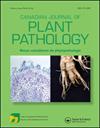Elevated expression of ribosome-inactivating protein (RIP) genes in potyvirus-resistant watermelon in response to viral infection
IF 1.5
4区 农林科学
Q3 PLANT SCIENCES
引用次数: 0
Abstract
Abstract Watermelon (Citrullus lanatus) is an important vegetable fruit crop, widely grown in many countries in the tropical and subtropical regions around the world. The narrow genetic base of cultivated watermelon makes it susceptible to many pests and diseases, especially viruses. However, genetic sources of resistance are available in wild relatives that could potentially be used to incorporate the resistance genes into watermelon cultivars. Ribosome-inactivating proteins (RIPs) are prevalent in many plant species and are known to have an important role in defence against bacteria, fungi, and viruses. The objective of this study was to identify RIP-like sequences in the watermelon genome and to conduct comparative measurement of RIP gene expression between the potyvirus-resistant Citrullus amarus ‘PI 244019ʹ versus the susceptible watermelon (C. lanatus) ‘Charleston Gray’ in response to infection by papaya ringspot virus (PRSV). Taking advantage of the recently available genome sequences of ‘PI 244019ʹ and ‘Charleston Gray’, in this study we mined out watermelon RIP genes and conducted comparative sequence and expression analyses of RIP-I and RIP-II between the genotypes. The RIP gene expression analysis revealed elevated RIP gene expression in resistant PI 244019 plants, but not in susceptible ‘Charleston Gray’ plants, in response to inoculation with PRSV, indicating a potential association of RIP gene expression and resistance to potyviruses in watermelon. This elevated expression of RIP genes in association with potyvirus resistance opens a new avenue to investigate the underlying mechanism of potyvirus resistance in watermelon.抗痘病毒西瓜中核糖体失活蛋白(RIP)基因表达升高对病毒感染的响应
西瓜(Citrullus lanatus)是一种重要的蔬菜水果作物,广泛种植于全球热带和亚热带地区的许多国家。栽培西瓜的遗传基础狭窄,使其容易受到许多病虫害,特别是病毒的影响。然而,在野生近缘种中存在抗性遗传源,可以将抗性基因整合到西瓜品种中。核糖体失活蛋白(RIPs)普遍存在于许多植物物种中,在防御细菌、真菌和病毒方面发挥着重要作用。本研究的目的是鉴定西瓜基因组中的RIP样序列,并比较测定抗痘病毒西瓜(Citrullus amarus ' PI 244019 ')和易感西瓜(C. lanatus) ' Charleston Gray '对番木瓜环斑病毒(PRSV)感染的RIP基因表达。本研究利用最近获得的西瓜‘PI 244019’和‘Charleston Gray’的基因组序列,对西瓜的RIP基因进行了挖掘,并进行了RIP- i和RIP- ii基因型间的序列比较和表达分析。RIP基因表达分析显示,接种PRSV后,抗性植株PI 244019的RIP基因表达升高,而易感植株“Charleston Gray”的RIP基因表达没有升高,这表明RIP基因表达与西瓜对多病毒的抗性可能存在关联。这种RIP基因与马铃薯病毒抗性相关的表达升高,为探究西瓜马铃薯病毒抗性的潜在机制开辟了新的途径。
本文章由计算机程序翻译,如有差异,请以英文原文为准。
求助全文
约1分钟内获得全文
求助全文
来源期刊
CiteScore
4.50
自引率
5.00%
发文量
56
审稿时长
6-12 weeks
期刊介绍:
Canadian Journal of Plant Pathology is an international journal which publishes the results of scientific research and other information relevant to the discipline of plant pathology as review papers, research articles, notes and disease reports. Papers may be submitted in English or French and are subject to peer review. Research articles and notes include original research that contributes to the science of plant pathology or to the practice of plant pathology, including the diagnosis, estimation, prevention, and control of plant diseases. Notes are generally shorter in length and include more concise research results. Disease reports are brief, previously unpublished accounts of diseases occurring on a new host or geographic region. Review papers include mini-reviews, descriptions of emerging technologies, and full reviews on a topic of interest to readers, including symposium papers. These papers will be highlighted in each issue of the journal and require prior discussion with the Editor-in-Chief prior to submission.

 求助内容:
求助内容: 应助结果提醒方式:
应助结果提醒方式:


